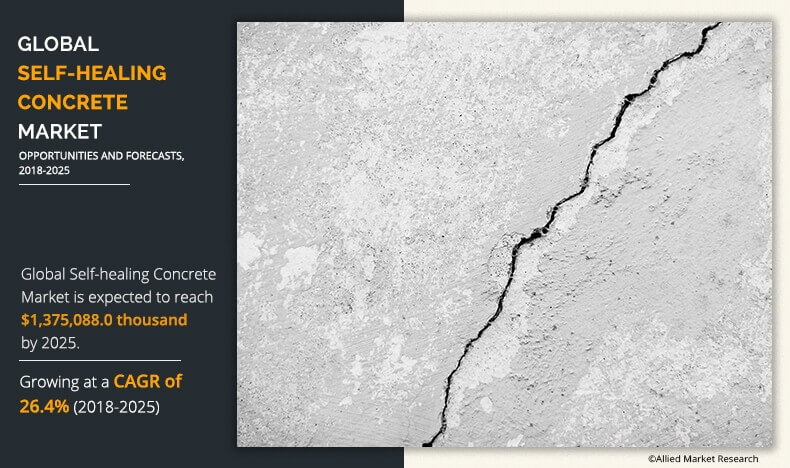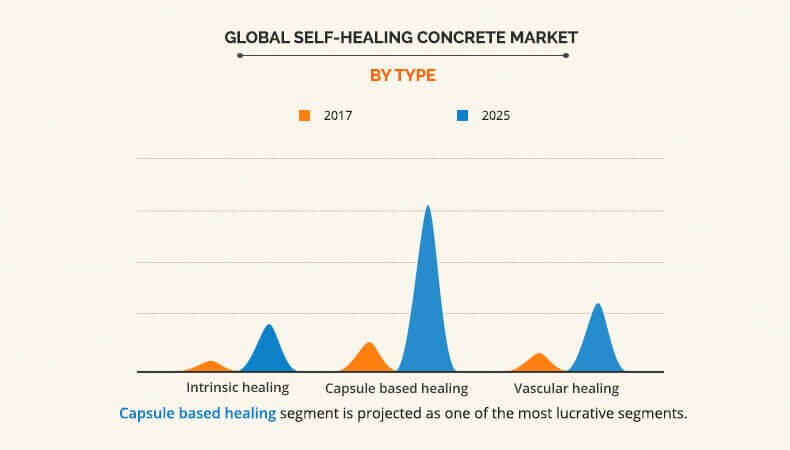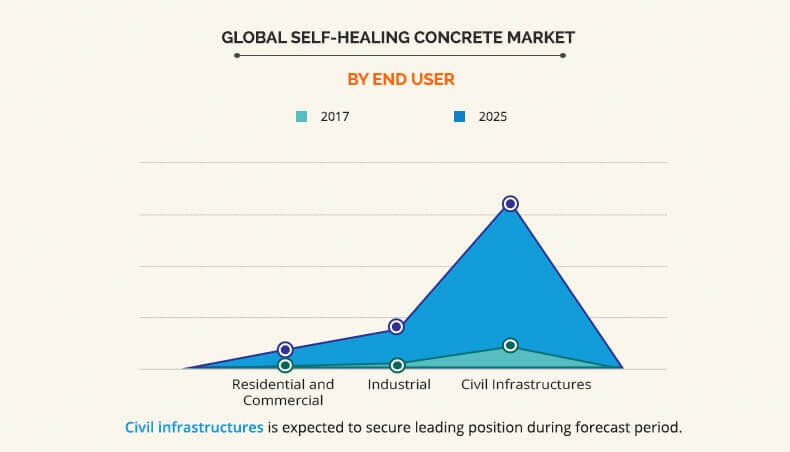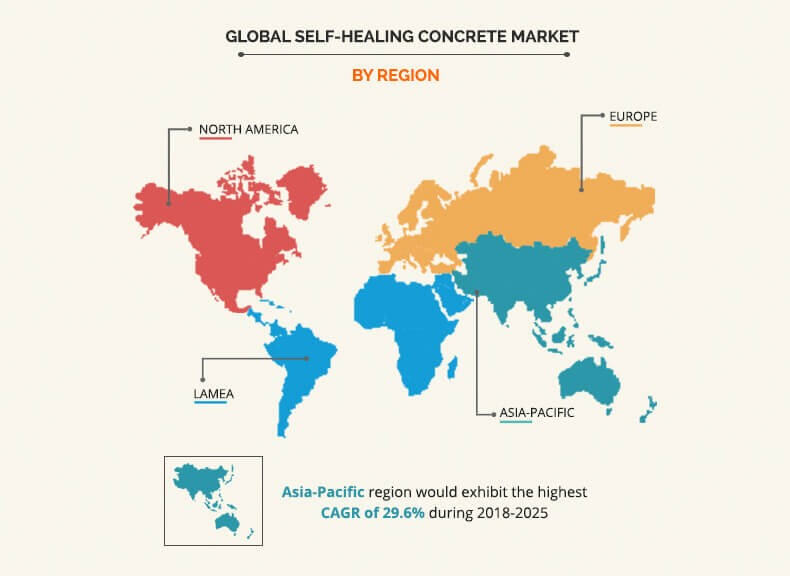Self-healing Concrete Market Overview:
The global self-healing concrete market size is expected to reach $1,375,088.0 thousand by 2025, from $216,720.0 thousand in 2017, growing at a CAGR of 26.4% during the forecast period from 2018 to 2025.
Self-healing concretes are bio concretes, generated with the help of Genus Bacillus bacterium group of bacteria that can survive in the alkaline concrete environment for years and produce limestone that can fill up and repair the crack. Favorable environmental conditions such as presence of water, nutrients, and oxygen helps spores to germinate and grow into vegetative active bacterial cells. Moreover, sealing of cracks and therefore protecting steel frameworks from external forces, which reduces the chance of corrosion, in turn improves the life of concrete structures. These factors mark the growth of the self-healing concrete industry. Industrial building is one of the main target of self-healing concrete providers. However, the market is still at nascent stage and will take long time to penetrate the market completely. Self-healing concrete has been examined by several researchers and some industrial concrete producers to find the remediation for the occurrence of small cracks. These cracks often lead to corrosion of the steel reinforcement and thus result in possible failure of the complete concrete structure. The general cost to repair these cracks leads to maintenance costs which can be of the order of 130 as direct costs per m3 of concrete.
Self-healing concrete market opportunity includes wide application base for reliable and durable construction. The wide area application of self healing concrete will help the adoption and boost the self-healing concrete industry in coming years. The residential, commercial, industrial and civil infrastructure are key component of economic growth. Hence, saving maintenance cost and increasing the life of these structures will ensure ample opportunities for various self-healing product to enter the market. The success of pilot projects being taken across globe will be decisive in promoting the market acceptance for self-healing concrete. However, lack of project results and higher self-healing concrete product cost is slowing down the growth of self-healing concrete market. In addition, the conventional material used in construction includes cement, mortar, lime, stone and other that ensure strength of the building once combined to be applied during construction. As the innovation takes a leap with self-healing concrete market introducing self-maintained mortar and mixtures in cement will mean the price are twice the normal material. This factor is leading to inhibitions in the adoption of self-healing concrete products among the end-users.
Factors such as increased life of civil infrastructures, ease of utilizing the product, and reduced maintenance cost are observed to be the key element of self-healing concrete market trends. In addition, rise in need for preserving the infrastructure also supplements the self-healing concrete market growth. Moreover, growth in building and construction industry increases the demand for self-healing concretes across the geographies.
The global self-healing concrete market is segmented into type, end users, and region. Based on type, the global self-healing concrete market is segmented into intrinsic healing, capsule based healing, and vascular healing. Based on end user, it is divided into residential and commercial, industrial, and civil infrastructures. Based on region, it is analyzed across North America, Europe, Asia-Pacific and LAMEA. The civil infrastructures segment is anticipated to dominate the self-healing concrete market throughout the study period.
By Type
Based on type, the market is divided into intrinsic healing, capsule based healing, and vascular healing. Among these, the capsule based healing segment held the largest market in 2017 and is expected to continue to grow at the highest growth rate during the forecast period. The capsule based healing is expected to show promising growth during the forecast period owing to its various benefits that includes healing of larger cracks, requires less external requirements to regain full strength and also stays protected during mixing.
By End User
Based on end user, the market is divided into residential and commercial, industrial, and civil infrastructures. Among these, the civil infrastructures segment was the highest contributor to the market in 2017 and is expected to continue to grow at the highest growth rate during the forecast period. The civil infrastructure is expected to be the highest beneficiary of using self-healing concrete, which will improve the strength of dams, tunnels, and roads. This in turn aims to increase the durability of various civil engineering structures that includes tunnels and bridges among others and also help to minimize the maintenance cost in the long run. All these factors are expected to propel the self-healing concrete market in civil infrastructures.
By Region
The market is analyzed across North America, Europe, and Asia-Pacific. Europe accounts for the highest share in the global self-healing concrete market and is projected to grow further at a significant CAGR due to the presence of huge construction and multiple research projects in the region. Moreover, countries such as China and Japan have huge potential to provide the required momentum for the market growth in the Asia-Pacific region.
Key Benefits For Self-healing Concrete Market:
- The study provides an in-depth self-healing concrete market analysis along with the current trends and future estimations to elucidate the imminent investment pockets.
- Key drivers, restraints, and opportunities and their impact analysis on the market is included in the study.
- Porters five forces analysis illustrates the potency of the buyers and suppliers operating in the industry.
- The quantitative analysis of the global self-healing concrete market from 2017 to 2025 is provided to determine the market potential. In addition, self-healing concrete market forecast analysis from 2018 to 2025 is also included in the report.
Self-healing Concrete Key Market Segments:
By Type
- Intrinsic healing
- Capsule based healing
- Vascular healing
By End User
- Residential and Commercial
- Industrial
- Civil Infrastructure
By Region
- North America
- U.S.
- Canada
- Mexico
- Europe
- Germany
- UK
- France
- Rest of Europe
- Asia-Pacific
- China
- Japan
- India
- South Korea
- Rest of Asia-Pacific
- LAMEA
- Latin America
- Rest of LAMEA
Key Market Players Profiled In The Report
- Basilisk
- Acciona Infraestructureas S.A.
- Avecom N.V.
- Comercializadora Espanola De Innovaciones Y Materiales
- COWI A/S
- Devan-Micropolis
- Fescon
Self-healing Concrete Market Report Highlights
| Aspects | Details |
| By TYPE |
|
| By END-USER |
|
| By Region |
|
| Key Market Players | Comercializadora Espanola De Innovaciones Y Materiales, Devan-Micropolis, COWI A/S, Fescon, Avecom N.V., Basilisk, Acciona Infraestructureas S.A. |
Analyst Review
Self-healing concrete is a smart material with the ability to repair cracks caused by mechanical friction or other factors on its own. The molecules of self-healing concrete re-adjust to replicate the original material. Self-healing of cracks in concrete is anticipated to contribute to a longer service life of concrete structures and is expected to make the material not only more durable but also more sustainable. The self-healing concrete market signifies a noteworthy growth due to increase in deployments in the emerging countries such as India, China, and others. Furthermore, upsurge in adoption of self-healing concrete in diverse industry verticals, owing to increase in investment in the manufacturing sector boosts the market growth. Furthermore, reduced corrosion of steel in concrete structure and increase in durability of steel reinforced concrete are other major factors that boost the demand for self-healing concrete in the market. However, high cost of bacterial concrete as compared to the conventional concrete is expected to hinder the market growth to a certain extent.
Self-healing concrete has more on-going projects in Europe, followed by North America, and Asia-Pacific. The highest share of the Europe market is attributed to the increase in investment to boost the projects initiated by Basilisk in the construction sector.
The civil infrastructure segment garnered the highest market share in 2017, owing to the increase in demand for self-healing concrete in this industry. This is due to increase in the adoption of this type of concrete in various structures that includes tunnels and bridges among others. Thus, Europe is expected to generate the maximum revenue share throughout the forecast period.
The key players profiled in this report include Basilisk, Acciona Infraestructureas S.A., Avecom N.V., Comercializadora Espanola De Innovaciones Y Materiales, COWI A/S, Devan-Micropolis, and Fescon.
Loading Table Of Content...







